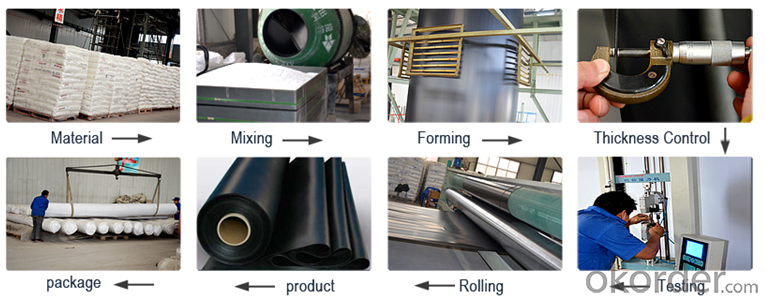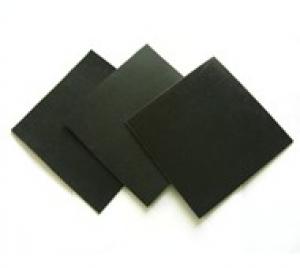Pre-Seamed Two Sides Textured HDPE Geomembranes for Wastewater Prevention
- Loading Port:
- Qingdao
- Payment Terms:
- TT OR LC
- Min Order Qty:
- 5000 m²
- Supply Capability:
- 500000 m²/month
OKorder Service Pledge
OKorder Financial Service
You Might Also Like




Two Sides Texturd Hdpe Geomembrane Specification :
| Thickness | 0.12mm-4.0mm |
| Length | 50m/roll,100m/roll,150m/roll or as your choice |
| Width | 5.0m-7.0m or as your choice |
| Color | White/Black/Blue/Green,mainly black |
| Material | HDPE |
| Delivery port | Qingdao |
| Package: | woven bag or as customers' requests |
| Product time | 2-20 days |
| Features | 1.Good physical and mechanic performance |
| 2.High tearing resistance, strong deformation adaptability | |
| 3.Puncture-resisting, aging resisting, ultra-violet radiation, oil and salt, and corrosion resistance | |
| 4.Good adaptability to high and low temperature, non-toxicity, long service life | |
| 5.Good waterproof, drainage, anti-seepage and damp proof effects | |
| 6.Complete width and thickness specifications, low cost and easy installation. | |
| Note | We can do as your demand,please feel free to contact us for more information |
FAQ:
1. How about the delivery time?
Two weeks upon receipt of down payment.
2. What kind of payments do we accepted?
T/T, L/C, WesternUnion, MoneyGram.
3. What's are the MOQ?
Normally the MOQ is 5000 SQM in theory.
And we can provide you free samples for quality inspection.
4. Do you charge for the samples?
Accordeing to our company policy, the samples are freee, we only charge the freight fee. And we will return the freight fee in your second order.
5. Can you produce the product according to customers' requirements?
Sure, we are professional manufacturer, OEM and ODM are both welcome
- Q: How to install the electrothermal?film?
- 1, Cleaning the ground and paving the extruded sheet of 2-3 cm thick. 2, Tailoring and laying the electrothermal film side by side according to the requirement. 3, Connecting the electric heating film parallelly (according to the standard construction connection drawings, single electrothermal membrane should not exceed 10 meters). 4, Using special tool to connect firmly the special clips with the electrothermal film metal loading bar and connecting the electric wire. 5, Wrapping connected parts with insulating plaster to prevent water and ensure insulation. 6, Allocating the air switch according to the total power, connecting the thermostat and sensor and putting the probe of the sensor probe into the area of the ground that is the easiest to be heated to prevent the heating film from being overheated. 7, adding the drive pipe to the sensor, cutting the drive pipe at the head of the sensor and sticking the sensor to the heated carbon strip of the electrothermal film with insulating plaster. 8, Checking it. 9, Wrapping the electrothermal film with waterproof cloth (for cement construction) or paving non-woven fabric (for floor or the floor sheet construction). 10, Starting the temperature controller to measure the temperature. 11, paving the geothermy plastic net, pouring cement mortar, inlaying floor tiles (cement construction) and paving the floor (floor construction) 12, The construction is completed.
- Q: The methods for sticking mobile phone film?
- 1. The environment: The place that need to be pasted with film should be in the bright light. If the indoors' light is too weak, then the small table lamp should be prepared to looke the details clelight is bright enough, indoors if too black is ready to small table lamp, light enough to see details. 2, wash their hands: First, clean up the dust and grease on the hand. Pay attention to use the liquid soap to wash. 3. Wiping the screen: Wipe the screen with a special fibre screen cloth, general senior film have specialized attached, if there is no can also replaced with glasses cloth or dropping the soft cloth, dip a small amount of water or special screen cleaning agent to rub, to clean up the clean surface dust, fingerprints for quasi. 4. Begining to paste: The tab 1 The thin?film is the protective layer rather than the using layer. To tear off the label from table 1 slow, then align the up and the left of the screen and paste it on. 5. The process: When pasting the film, keep a constant speed. And when there are appearing bubbles, please pull back and ensure no bubble on the surface. Then scraper the blade with wool scraper or cushion. You should scratch it slow to avoid damaging it. To press the surface of the mobile phone, the instant bubbles will be very small. 6. To repair: After pasting, and then make a restoration of the bubble in some areas. Use the hard card and credit card, just wipe the card with the soft cloth and slowly scratch the bubble out of. If there are any small dust particles on the surface, please uncover the block and paste it up with the adhesive plaster, and then paste the stick membrane well. If the good paste screen is only with only tiny bubbles, it generally disappears within a week automatically.
- Q: How does the construction of the soft film ceiling?
- 1. First to go to the site to see if there is a condition of installing the keel: Look at the scene to make sure the wall is completed, and woodworking processing part is qualified, the area that need to be plastered should be completed first. First part plastering carpentry part we proposed must be in accordance with the requirements to do, to advance the processing of.2. entering the construction site conditions Licensor hole size lamp, air outlet, first part is fixed according to the design Aluminum Alloy keel keel carpentry requirements drawing well, attention must be right angle connecting to smooth, flat, dense.3. lamp holder, tuyere, light tube plate to and around the keel level, and firmly cannot swing can smooth.4. smoke, ceiling lamps, the first position to make a wooden frame, wooden frame the bottom surface should be polished, and pay attention to the level of height is too low, it is easy to show a trace of.5. before installing ceiling, carefully check the keel joints are solid and smooth, the spray head to stick on the white tape, an outlet should be well handled. When loading the smallpox to first from the middle to both sides of the fixed, while paying attention to size on both sides and pay attention to welding seam to the final straight angle position, pay attention to smooth. Around the well to the smallpox pruning removes. To perfect income effect on the edge. Turn on the light hole. To mark the position of the lamp hole , and carefully stick the PVC lamp ring carefully and accurately on the bottom of the soft film and then remove the excessive smallpox after it is firm. Find the position of the outlet and the light pipe handicap, just as the surroundings, to install the soft film to the aluminum alloy keel, pay attention to keep the angle be smooth.
- Q: Reservoir, the dam foundation is weak, the dam earth membrane seepage control design, the geotechnical membrane in the dam before the need to extend long? Are there bases?
- In order to be used for the use of geotechnical membrane anchorage ditch, the geotechnical membrane in the dam before the need to save about 2 meters
- Q: How to stick mobile phone film?
- 1. Clean the screen with BG cleaning cloth (or fiber soft cloth, glasses cloth) thoroughly. It is better to clean the screen indoors in a neat condition without air flow to reduce the influence of dust. If there is dust on the screen, bubbles will stay between the membrane and the screen which means the failure of sticking membrane. Membrane will become useless when there is dust between it and the screen which damages the silica gel layer of packaging film. 2. Wipe off the stubborn?dirt with BG dedusting paster. If there is stubborn?dirt remaining on the screen, clean the screen with dry cleaning cloth. Wet cloth should not be used. Dedusting paster can stick the dust. So it can be used to clean the screen. Stick dedusting paster back to the original backing paper after using it. Then the paster is recycled. 3. Check the membrane. Take the membrane out of the package. Do not tear off the release liner directly. Put it on the screen of the cellphone, check if the membrane is suitable. Make clear of the place to stick membrane. This will help in later steps. 4. Tear off the first release liner partly. Pay attention to not touch the part of protective membrane exposed with your finger. Each cellphone film is composed of three layers. The first and the last are release liners to protect the protective membrane sandwiched between them.
- Q: Can geomembranes be used in sewage and sludge storage facilities?
- Yes, geomembranes can be used in sewage and sludge storage facilities. Geomembranes are impermeable liners made of synthetic materials that provide a barrier to prevent leakage and contamination. They are commonly used in environmental containment applications, including sewage and sludge storage, to ensure the integrity of the storage facility and protect the surrounding environment from potential pollution.
- Q: What are the advantages and disadvantages of ceramic and metal film membrane?
- Ceramic membrane material is acid and akali resistance, anti chemical solvents, high temperatures resistant, especially with high mechanical strength, long service life. it has obvious advantages in harsh environments. The disadvantage is that the application of ceramic membrane is not wide enough, although it is nanoscale separation precision. ceramic membrane has a small market, but there is no ceramic membrane that can not filter.
- Q: The installation method of soft film ceiling.
- A soft film ceiling installation should be completed with the coordination of the construction to ensure the quality and time. 1. Before the entering of soft film smallpox the site should be energized and without building waste. 2. The deal with the bottom of the piamater ceiling should be fit for the installation conditions, such as the installation of the steel and so on; it must be cleaned. 3 all lighting and lighting fixtures must be installed according to the required size.
- Q: Can geomembranes be used for canal lining?
- Yes, geomembranes can be used for canal lining. They are commonly used as a reliable and effective solution for preventing water seepage and maintaining water levels in canals. Geomembranes provide a durable barrier that helps to reduce water loss and improve water conservation in irrigation and water management systems.
- Q: What are the long-term performance characteristics of geomembranes?
- The long-term performance characteristics of geomembranes can vary depending on factors such as material type, installation quality, and environmental conditions. However, in general, geomembranes are designed to have excellent durability and resistance to various environmental stresses such as UV radiation, chemical exposure, and temperature fluctuations. When properly installed and maintained, geomembranes can provide long-term performance by effectively preventing leakage, protecting against contamination, and maintaining structural integrity.
Send your message to us
Pre-Seamed Two Sides Textured HDPE Geomembranes for Wastewater Prevention
- Loading Port:
- Qingdao
- Payment Terms:
- TT OR LC
- Min Order Qty:
- 5000 m²
- Supply Capability:
- 500000 m²/month
OKorder Service Pledge
OKorder Financial Service
Similar products
Hot products
Hot Searches
Related keywords


































